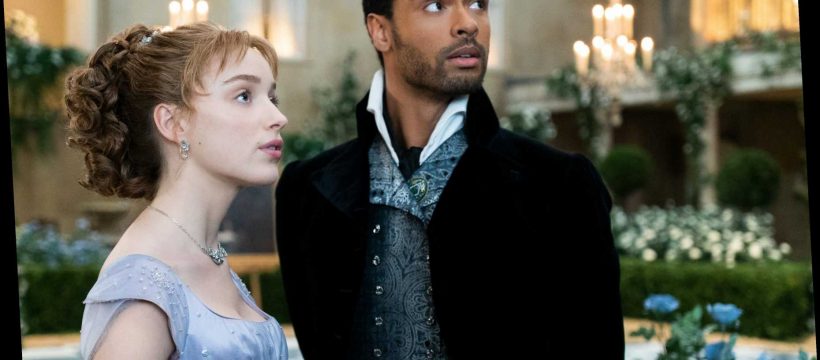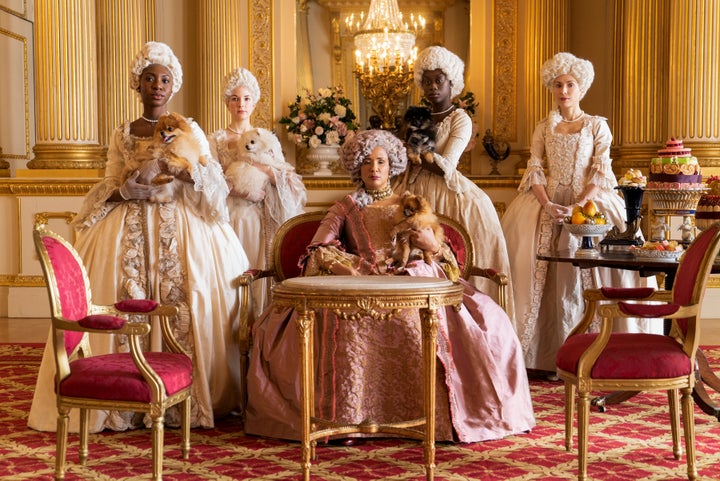I was deep in a Regency romance binge a few years ago when I pitched a highly self-interested piece to my editor: an investigation into why this didn’t exist onscreen.
This was a creature apart from the Jane Austen adaptations and sedate period pieces I already enjoyed, or sexy but bloody cable costume dramas. A Regency romance is set in a fantasy version of British high society in the early 19th century, and the central action revolves around the courtship between a woman (often a well-bred beauty) and a man (often a rakish peer). They consummate their attraction in improbably acrobatic sexual encounters, and then they live happily ever after.
In the post-2016 election malaise, these novels became my anxiety palliative of choice. They piled up next to my bed and in my e-reader. But sometimes I wanted more, wanted to see the gossamer petticoats and lingering glances and gently unfastened bodices. The piece I pitched never materialized, but the object of my longing did. On Christmas Day 2020, Shondaland’s “Bridgerton” arrived on Netflix.
What ensued was both somewhat exhilarating — getting to see my Regency escapism come to life — and unnerving. My private indulgence, one generally viewed with dismissiveness if not contempt by non-romance readers, had become the target of a full-blown cultural discourse. “Bridgerton” was met with valid and vital critiques, especially over its treatment of consent, but also ones that made me wince: that it was formulaic, predictable, vapid, historically inaccurate, best suited for teens.
Many of the critiques, understandably, seemed rooted in unfamiliarity with the genre’s conventions, or in the expectation that “Bridgerton,” which is based on a series of books by Julia Quinn, would resemble a “Pride and Prejudice” remake. “You don’t get it!” I wanted to shout. “That’s not what this is!” The historical romance has finally gone mainstream — and that means a whole new audience is learning how to read a genre so long relegated to the margins. Sometimes that can be a bumpy ride.
With its bounty of sherbet-hued satin gowns, scandal rags full of malicious gossip, unblinkingly earnest romance, and on-screen lovemaking, “Bridgerton” seems to defy easy categorization for many critics, journalists and viewers — and even Regé-Jean Page, who stars as the smoldering Duke of Hastings.
“It’s a little bit of Jane Austen meets ‘Gossip Girl’ with maybe ‘49 Shades [of Grey’],” he told The Wrap in a December interview. Critics and viewers, at their wits’ ends trying to make sense of this sexy, gossipy, frothy Regency costume drama, also tried to characterize it in terms of beloved on-screen classics: “Pride and Prejudice,” “Downton Abbey,” and, yes, “Gossip Girl.” These comparisons convey some bafflement, an uncertainty about how to categorize a show that isn’t really a realist historical drama, nor an edgy satire, nor a campy soap.
Though it’s true that Austen was the inspiration behind the whole subgenre — the first Regency romance novelist, Georgette Heyer, was emulating Austen’s work — it has evolved into a well-established genre with its own tropes, conventions and standards.
“There’s a way that those kinds of incredibly popular adaptations of Austen will make you, I think, expect that you’re watching a certain kind of thing, and romance novels are not trying to do the same thing at all,” critic Aaron Bady said in a phone conversation. “If you go in watching ‘Bridgerton’ and say, ‘I think I’m watching Jane Austen,’ you’re going to be disappointed. It feels a little Jane Austen-y, but it doesn’t work like a Jane Austen novel.”
Nor is period romance merely a form of realist period fiction. In her review of the show, Patricia Matthew, an associate professor of English at Montclair State University, placed it in a long artistic tradition of Black women depicted in Regency settings. But ultimately, she said in a phone interview, “Nobody’s reading Julia Quinn because they’re looking for disquisitions on historical precedent.”
Bursting though a romance novel may be with carefully researched, period-accurate details about Vauxhall entertainments, Almack’s vouchers or ribboned chemises, these novels really aren’t about the Regency era, or at least not primarily.
“Historical romance does a different kind of work than historical fiction,” Sarah MacLean, a popular historical romance author, told me during a phone call. “The work of the romance novel is not to tell the story of the past. It is to hold a mirror to the present.”
By building a love story between the primary couple, one that is guaranteed to end “happily ever after” or “happy for now,” a romance novel not only provides escapism and the heart-pounding rush of vicarious passion, but a space in which to explore how romantic relationships can and should be, and how women can find fulfillment and happiness. And that means these stories have little to do with how the marriage market of Regency high society actually functioned; they’re about what readers — predominantly women — want to see in their lives today.
“The appeal of the time period for readers is very much about being able to distance readers from certain kinds of social issues and then reframe them as a reflection of society now,” MacLean explained. In the 1970s, novels typically featured brooding alpha males who took what they wanted sexually ― a narrative device, MacLean argued, for the fictional heroines of the time to have plenty of sex without being seen as loose and deserving of punishment. Historical romance novels today often feature heroes and heroines having what seem like rather anachronistically tender exchanges about consent.
Ella Dawson, a sex and culture critic, sees period romance as a way to provide a balm — an experience in which violence and trauma are, if not absent, superseded by a reassurance of ultimate well-being — while also walking readers through more thorny questions.
“Romance as a genre is really interested in consent, in diversity representation, in political issues,” she said. “Romances are so infused with these issues that I [am] really passionate about, and they explore it through this really fun, romantic, swoony, but still very intellectual, thoughtful, accessible lens.”
As odd as it felt to see a straightforward romance adaptation dissected as if it were a failed attempt at matching Jane Austen, it makes sense. Because the genre is generally regarded with such disdain in mainstream culture, it occupies a rather marginalized niche. A non-romance reader is unlikely to have a firm grasp of many things about the genre, outside of well-worn jokes about throbbing members and Fabio’s flowing hair, and though romance is among the bestselling genres in the book industry, it’s rarely adapted for TV or film.
Why has this omission persisted for so long? “I can’t imagine that it isn’t a huge amount [due to] patriarchy, in the sense that for the same reason it gets disdained on the page, it gets disdained on the screen,” said MacLean. To this day, the people deciding which films and shows to finance are almost entirely men. Shonda Rhimes is that rare exception — a woman with creative control over a TV empire, and a fan of the Quinn series.
Practical obstacles to adapting romance also pop up. A novel stuffed with sex scenes and building toward a tidy happy ending may be tricky to adapt for network TV, which needs to keep things a bit cleaner — and keep the narrative drama going indefinitely.
And it’s not just the network TV standards and the tidy endings. The heightened reality and bodice-unclasping of the genre, Matthew said, rely on an intimacy between the reader and the page that’s difficult to translate to the screen.
“I think the plot lines are bananas. I think they’re so extreme that they strain credulity,” she said, laughing. “You have to believe that a sane man, an adult, would say, ‘Oh, I’m just not going to have children so I can spite my father.’ It only works if it’s you with a glass of wine, kind of throwing yourself over to the world of romance.” It’s awkward to sit with someone else, knowing they’re watching the same melodramatic story unfold, partaking in a pleasure that feels somewhat private, if not embarrassing. “We all have these fan worlds that when they’re exposed to other people that aren’t a part of that world we might feel protective of, or feel bashful,” she said.
Then there’s the money question. Whereas romance novels are relatively cheap to publish, printed in the most inexpensive format (mass-market paperbacks) and typically garnering small advances for authors who churn out multiple volumes per year, the vision they conjure is decadent, over-the-top. “There’s a sumptuous world that has to be depicted, and it seems like that’s a very expensive endeavor,” Matthew said. (“Bridgerton” reportedly had an eye-popping budget.) On camera, the heroine’s jewel-encrusted gown costs far more than some well-chosen keystrokes. The visual equivalent of a $7.99 mass-market volume calls for a prestige TV budget. And for a prestige TV budget, many viewers expect a period piece to be an ambitious work of art, not a faithful adaptation of a cheap paperback they might see in a grocery store aisle.
When we see the telltale signs of a period piece, we have reason to expect something that will submerge us in the era being depicted, in all its grit as well as its glamour. As Jane Hu wrote in a skeptical Vulture review of Netflix’s other recent soothing period hit, “The Queen’s Gambit,” “the visually ornate period piece approaches something like a nostalgic fetishization of whiteness in decline. They should not make one feel: ‘I want to go to there.’ Instead, the effect is more like: ‘I can never go back there again.’”
When we see such a glossy period piece, in other words, we expect the trenchant historical insight of a “Mad Men” or Austen — not Harlequin. Not “I want to go to there.”
But this, as Bady wrote in an essay on “The Queen’s Gambit,” is not really the Netflix way. “Netflix is TV that you binge or chill or fall asleep to, TV for relaxing,” he wrote. “[T]he immaculately rich interiors and production detail of ‘The Queen’s Gambit’ make it less a period piece than a kind of fantasy of what the past was like, or could have been, the past re-imagined as product.”
Netflix makes historical shows that salve our anxieties with a past where, as he puts it, “nothing bad happens.” In a very real way, this is what the Regency romance genre is, part of its particular appeal: They’re gorgeous, escapist stories that end happily ever after.
“The idea that historical romance would be able to unpack and solve these big issues of colonialism and race and gender and sexual politics and identity from a massive lens is unrealistic when the books are really doing a very specific kind of work around the domestic role of women and other marginalized people in our current society,” MacLean said. “The work of the romance is to show characters in hope and prosperity and joy and love.”
It’s not, in other words, to expose the decay at the heart of Regency-era society. Perhaps it was inevitable that Netflix and Rhimes would be the ones to plunge full-throttle into a genre defined by happy endings, unqualified pleasure, and a vanished historical setting that looks good enough to eat.
But if historical romance is not, as a rule, a genre interested in undermining our nostalgia for an imagined, bygone golden age, it is also not empty of political concerns ― and the easily mocked anachronisms common to the genre, like the empowered heroines who are determined to find a love match or embark on a scholarly career, reveal what’s really at play in the worlds of these books.
“There’s all of these ways that these novels themselves are trying to have it both ways, to give audiences a world of fantasy ― a world of the aristocracy, where everyone’s lives look very elegant, people go to balls, women are swept off their feet by dashing rakes, and in return reform the rakes with their love,” said Matthew.
At the same time, she said, we don’t want to see heroines who are marriage-obsessed and weak. She pointed to the scene in which Daphne Bridgerton punches a loutish suitor who attempts to compromise her, as a moment that would not have appeared in a Regency romance even a few decades ago. “I think it’s a response to our audience needs, not to see women as simply in the service of strong, often wicked men,” she said.
Historical romances live in these tensions — the escapism of another time battling against the more enlightened social attitudes of the modern era; sheer fantasy coexisting with a critique of gender roles, or even the slave trade and colonialism. “Happily ever after has a tremendous amount of power that I think is subversive in many ways,” said MacLean. Much of that has to do with telling stories in which women find joy and comfort rather than being harmed or neglected.
For Black women, this is particularly true. Though the romance world has been undergoing a painful and overdue reckoning with racism in its institutions (most notably the Romance Writers of America), Black romance novelists including Alyssa Cole, Vanessa Riley, and literary legend Beverly Jenkins have found in the genre a way to center Black women’s happiness and care, both in contemporary settings and in historical ones.
Though Quinn’s Bridgerton novels are entirely white, the Shondaland adaptation featured diverse casting to controversial effect. In a Medium essay on the series, Tressie McMillan Cottom argued that the adaptation’s addition of people of color to “Bridgerton” coupled with a light-handed explanation of their presence, made historical escapism possible for Black viewers, who are often confronted with brutal reminders of slavery and colonialism when consuming historical fiction. The show, she wrote, offered “just enough realism to give a Black viewer permission to suspend disbelief” and enjoy the sumptuous sights and passionate sighs.
That’s the comfort of the genre: It doesn’t intend to thoroughly represent or deconstruct all the ills of society. Instead, a successful romance constructs a world that directs you to focus on a story of love and possibility, and it lets that be sufficient.
“The economics and politics of that world that Bridgerton makes, it just makes no sense. And that’s fine, that’s not what they’re trying to do,” Bady said. “There’s a way that the show is telling you, here is how to enjoy this. Don’t really worry about other things. I think that’s a big part of how genre works.”
Matthew also told me that because of the particular genre, she’s not interested in “scolding the series for not matching the history that I know it comes from.”
“But having given it the multicultural world,” she went on, “I’m really looking forward to what they do with that moment.” With Marina, a young mixed-race debutante who gets pregnant out of wedlock and needs to enter a marriage of convenience, she sees possible groundwork being laid for a more subversive kind of story than the conventional, white Regency romance.
“You had that figure of the ‘tragic mulatto,’ who’s the mixed-race woman whose narrative requires her to have a bad end,” Matthew pointed out. “[Marina] is drawn with a different set of challenges to face that mirror Daphne’s around childbirth. But I think she’s also a woman who is loved and respected. That’s not how that narrative usually unfolds … they make her such a sympathetic character without making her weak or obsequious. She’s beautiful and playful and making the best of a situation.”
With careful writing in future seasons, she said, “I think there’s a lot that could happen with these characters of color that doesn’t reduce them to being characters of color while still acknowledging that there’s a historical trajectory that brings them there.”
Acknowledging the show as a certain kind of fluff, even giving oneself over to the pleasure of the escapism, doesn’t mean disengaging critically. Some critics who love the romance genre hated “Bridgerton”; others loved it; others felt all kinds of complicated things about it. The shocking scene in which Daphne, Season 1’s heroine, sexually assaults the Duke in order to get pregnant against his wishes, has received particular scrutiny. Some romance lovers, like Matthew, cringed at the sex scenes, while others (guilty) found them deliciously steamy.
Dawson noted that while she has plenty of issues with the show and the source material, including its troubling portrayal of nonconsensual sex, “as far as adaptations go, it did a fantastic job adapting what it is like to read a romance. It included so many of the little genre touches that make romances so satisfying ― the physicality, and the tension, and the anticipation.”
A romance isn’t meant to be restrained and biting like Austen, or a gritty work of art like “Mad Men,” or even a constant churn of drama like “Gossip Girl.” It’s a show about the slow build, and the explosion of passion. “The sex is a payoff! They fall in love, and there’s a payoff! They’re happy at the end!” MacLean said, quoting a male friend of hers who discovered romance ― and the purpose of all those erotic scenes — through “Bridgerton.”
And amid all the sex and swooning and utterly frivolous fashion, there are stories about the relationships we want to have, the work that goes into making them, and the social context that shapes them. “Bridgerton” isn’t Austen, but it never claimed to be. Romance is its own kind of story, and, as many critics and fans have discovered, it’s worth paying attention to — on its own terms.
Related
Trending
Source: Read Full Article







